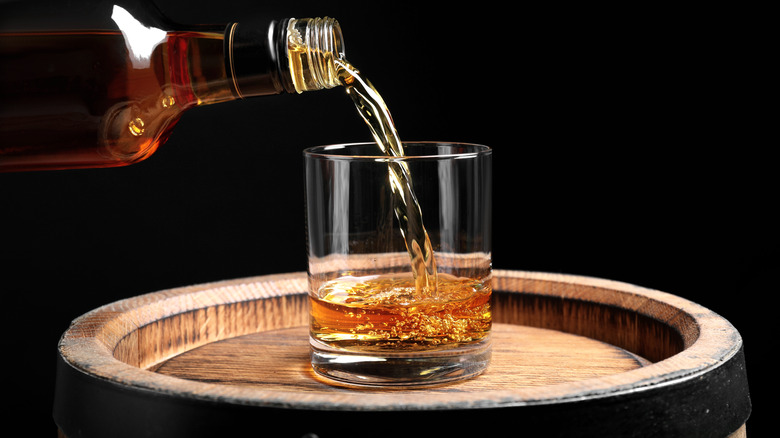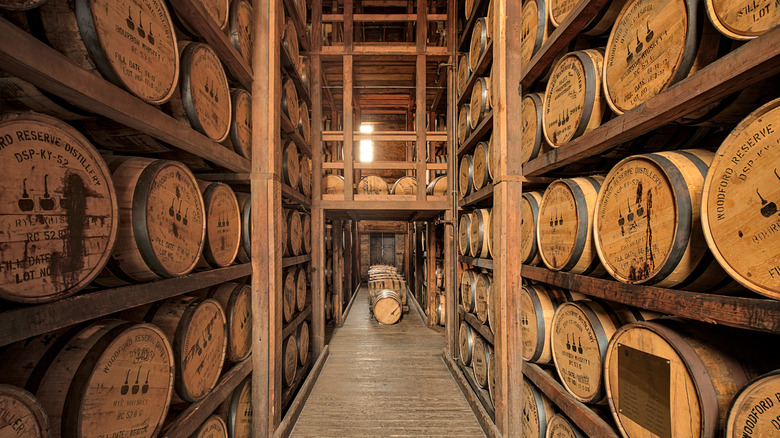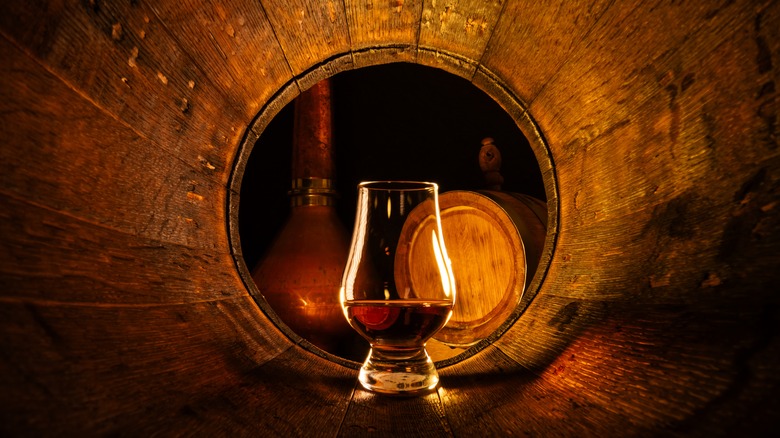How Much Whiskey One Barrel Actually Holds, In Bottles
If you've ever had the pleasure of touring a whiskey distillery, you'll have noticed the huge wooden barrels that are used to age the spirit before it is bottled. While they are often used interchangeably, the word barrel specifically refers to a wooden cask that is a certain size and shape; all barrels are casks, but not all casks can be called barrels.
Usually made from white oak, which adds flavor as well as being watertight, casks can come in different sizes, and there are no U.S. regulations that stipulate a specific size that distillers must use. But the most commonly used for aging whiskey, and especially bourbon, is the American Standard Barrel, which holds around 53 gallons. It should be fairly straightforward, then, to work out how many standard 750-milliliter bottles you'd get out of one barrel: just over 267.
But it's not quite that simple when it comes to whiskey. The size of the cask is not the only factor that determines how many bottles it can produce. That's because the whiskey is not bottled straight away; it undergoes years of aging in the barrel. And as the whiskey ages, several other aspects also come into play, including evaporation and how the whiskey is bottled. After all that, you could actually get anything from 200 to 300 bottles from a single barrel.
Aging and angel's share affect the volume of whiskey
Whiskey spends several years aging in the oak barrel or cask; it's what the age number on the bottle refers to, with longer aging often commanding higher prices. But there is a minimum length of time it must age before it's bottled depending on type – at least two years to be classified as bourbon, and at least three for Scotch whisky — though some can aged for over 50 years. Bonded whiskey must be aged for a minimum of four years. The time spent in the cask adds around 60% of the delicious flavors we come to associate with the spirit, as well as being what gives whiskey its signature brown color. But it also affects how much whiskey remains.
One of the factors that affects the volume is the angel's share of whiskey, which refers to the natural evaporation that takes place as it ages — or the amount that goes up to the angels. The longer the liquid is kept in the barrel, the more whiskey is lost, at an approximate rate of around two percent for each year it ages.
There are many factors that determine exactly how much whiskey is 'lost to the angels,' and it's not just about how long it spends in the barrel. These include where the distillery is based geographically, the climate and temperature, the composition of the barrel itself, and how it is kept.
The strength of the whiskey affects the number of bottles
How the whiskey is prepared for bottling also affects the volume produced. Sometimes the whiskey is diluted with water or undergoes filtration, which lowers its alcohol by volume to around 40 to 46 percent. This process means you can get more bottles from each barrel.
On the other hand, if a whiskey is labeled as cask strength or barrel-proof, it means it's bottled straight from the barrel with no dilution, giving it a much higher ABV of 60 to 65 percent. This means fewer bottles can be produced from a single barrel, and it's one reason why these varieties are often more expensive.
But again, it's not always that simple. While the 53-gallon American Standard Barrel is commonly used for aging whiskey, notably bourbon, which only uses new charred white oak barrels, it's not the only cask that is used. Sometimes, whiskey can be finished in a cask that had previously been used to age different alcoholic drinks, such as sherry or wine. And the different types and sizes of casks used by different distillers also affect how many bottles you get. So, how many bottles of whiskey can you get from a barrel? The short answer is — it's complicated.



